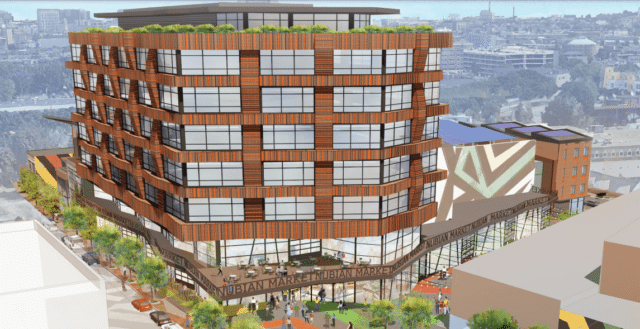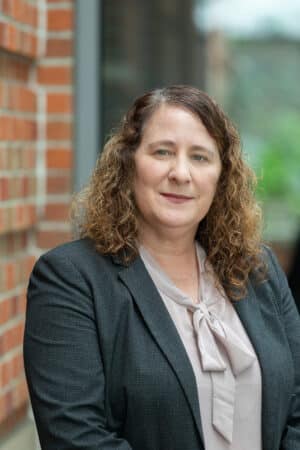Karen Kelleher
President, BlueHub Loan Fund
Age: 55
Industry experience: 30 years
Coming off the biggest lending year in its history, Roxbury-based BlueHub Capital is seeing no let-up in demand for its services as an intermediary piecing together financing packages for real estate projects in low-income communities. The Robury-based community development financial institution has participated in financing for notable projects ranging from mill conversions in Holyoke and New Bedford to the new Franklin Cummings Tech building that broke ground last month in Nubian Square. Last summer, former Local Initiatives Support Coalition Boston executive Karen Kelleher was named new president of the BlueHub Loan Fund, which originates over $100 million in annual lending for projects in low-income neighborhoods.
Q: What’s the best way to describe BlueHub Capital’s role in the real estate financing ecosystem to people not familiar with the organization?
A: We are a mission-driven nonprofit lender that brings a lot of sophistication and agility to the table to make projects happen, predominantly in the low-income communities and communities of color such as Nubian Square. We are a national organization and have lent in 28 states, but a significant amount of our focus remains in Boston and in Massachusetts. We play an intermediary role between the lenders and the people who have capital.
Q: How is the current investment and interest rate climate affecting demand for your products?
A: There are always gaps in our world, and they are bigger right now. There is a greater need for affordable housing and more political support, but always not enough resources. The state and the city of Boston have stepped up, but there is never enough. Those projects are slowing, and they need more capital to get across the finish line. We are often the early-stage capital lender, such as an acquisition loan, sometimes over 100 percent loan-to-value – certainly above the 80 percent that banks are willing to take on.
Our borrowers don’t always have deep pockets. As rates have come up, it’s very difficult to come to the table. Our cost of capital is going up too, so we have to be creative. Sometimes we take a subordinate lien that acts as a gap filler for developers that are doing really impactful projects.
We also do lending to early-stage charter schools. In the past, we would typically be a subordinate lender to a first mortgage lender, and we would add some capital to the stack. We’re being asked now to take on the entire debt now. A lot of the mission-driven organizations are capital-constrained.”

BlueHub Capital provided a $3 million predevelopment financing package, including a $1.5 million MassDevelopment loan guarantee, for the Nubian Ascends mixed-use development planned for the heart of Boston’s Nubian Square. Image courtesy of Stantec and Dream Collaborative
Q: What are the needs of your clients driven by sustainability projects?
A: BlueHub has a deep history of investing in climate justice, and understanding how climate resiliency intersects with low-income communities. We have a lot of work with affordable housing for climate resilience and decarbonization, and the state’s [low-income housing tax credits] qualified allocation plan prioritizes Passive House construction.
Increasingly, the state is subsidizing the decarbonization of existing buildings. We have a pilot program in Codman Square where we put electric vehicle charging stations in an affordable housing project to make EVs more accessible to a low-income community, but also to make the grid more resilient. If there’s a power outage, the property can pull power off the car batteries to run emergency lighting. We’ve funded a lot of conversions to solar, and will keep doing that.
Q: What are your immediate goals for the BlueHub fund?
A: I want to make sure I can raise the capital I need for our pipeline. Our EQ2 product is a way for [Community Reinvestment Act]-motivated banks to make an investment commitment for a longer period of time. It’s low return, but they get CRA credits every quarter. It’s a powerful tool and a great start to a relationship for a bank that may not already be investing with CDFIs.
We just had our biggest year ever from a lending volume perspective and expect to continue to grow our team and our pipeline. That gives us the opportunity to be more engaged. Boston and Massachusetts are doing things that are really innovative and impactful, but our national platform and reach gives us the ability to take the innovation here and bring it to other places. We view ourselves as ambassadors for Massachusetts and Boston, but we still do 20 to 25 percent of our lending in Massachusetts.
Kelleher’s Top 5 Ways to Celebrate Spring in Greater Boston
- Visit the Custom House Tower observation deck.
- Explore Franklin Park, the Emerald Necklace’s crowning jewel.
- Take a lunch to the Kendall Center’s roof garden.
- Stroll any part of the Boston Harborwalk.
- Tour the Punto Urban Art Museum in Salem or the Western Avenue Open Studios in Lowell.






